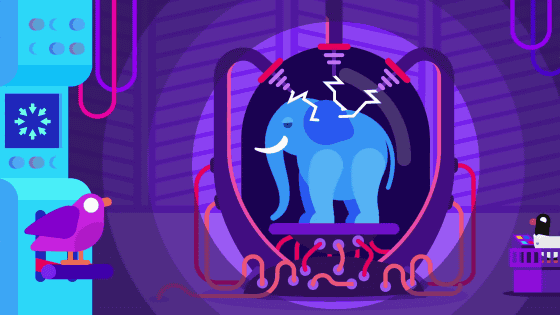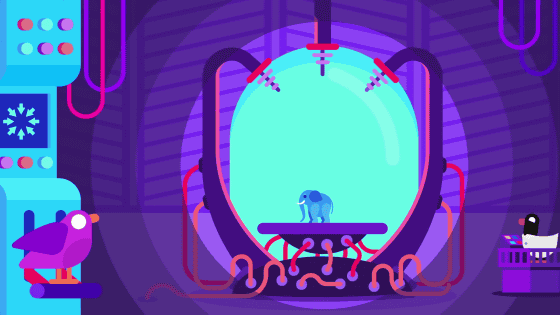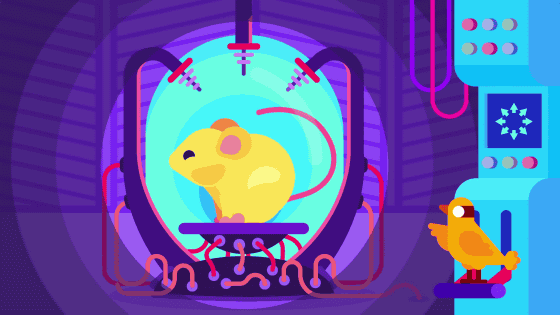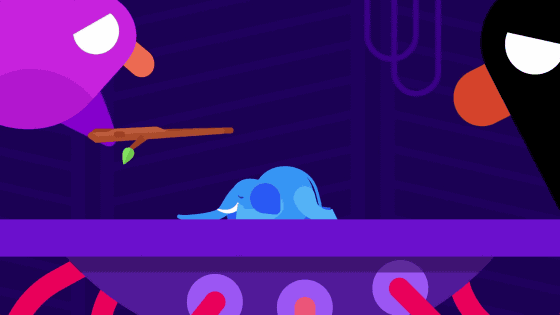What is the reason that if you eclipse an elephant with a small light it frozen instantly and die?

Popular as a secret tool for DoraemonSmall lightWhat happens when you use an elephant in the palm size using? When thinking scientifically, the answer is "to freeze and die instantly". Conversely,"Big Light"When rats are enlarged, they immediately emit a large amount of heat from the body and died immediately. A movie that explains "the size of animals and the amount of activity of cells" that solves this mystery "How to Make an Elephant Explode with Science"Has been published.
How to Make an Elephant Explode with Science - The Size of Life 2 - YouTube
An elephant, a representative of a big animal ......

Small to mouse size ......

What will happen if you enlarge rats to elephant size?

The elephant gets cold soon and dies ... ...

On the contrary the mouse gets hot ...

It explodes and dies.

Animals have a body structure that is suitable for the natural environment.

This means that you can not live in another environment. The element "body size" becomes important here.

Every animal is made up of "cells".

Actually, the cell itself has a similar structure in any animal.

The blue whale's cell is not much bigger than the hummingbird's cell ......

However, it is said that the blue whale is made of far more cells.

Every tissue in the cell consumes energy.

Energy is created by chemically reacting food and oxygen.

It is the intracellular "mitochondria" that plays an important role in producing energy

MitochondriaATPWe create easy-to-use energy called.

Mitochondria is like a steam engine, it generates heat when generating energy.

The human cell membrane increases to 50 degrees Celsius.

How to handle the heat generated by mitochondria, which contains as many as 2000 cells in the cell, is an important issue for animals to live.

Because large animals in the body have more cells than small animals in the body, the heat generated in the cells in the body increases according to the size of the body.

The element related to the size of the animal is "body length (length)" ...

"Surface area" ...

Three volumes (volume) in the body such as organs and bones.

Each animal properly balances the heat generated inside the body and the heat released to the outside of the body.

If the rat's body gets bigger, the heat generated inside the body will far exceed the heat that can be released.

For clarity, let's think of it as a small one centimeter square cube.

If the length doubles ... ...

Surface area is not doubled but quadrupled.

The volume will be 8 times.

The surface area is proportional to the square of the length, and the volume is proportional to the cube of the length becomes a problem in determining the size of the animal.

In other words, it is difficult for a large animal to exhaust the heat generated by many cells.

If you make the size of a small animal mouse 60 times, ...

The surface area is 3600 times ... ...

The volume will be 216,000 times.

Since the surface area does not increase as volume increases, waste heat can not catch up with it.

Therefore, the heat generated inside the body gather ... ...

It will explode.

So, how does an elephant with a huge size handle the heat generated in the body?

It is certain that it is exhausting with an ear with a much larger surface area than a human being. However, this is not so effective for waste heat.

Elephant cells respond to thermal problems by significantly lowering the rate of activity compared to rat cells.

The amount of cellular activity is inversely proportional to the size of the body.

Although the scale of the graph is not accurate, the metabolic rate decreases dramatically as the body size increases.

In other words, elephants are made up of "cold cells" with little metabolism, small activity volume.

In elephant cells, mitochondria is also slowly active.

Unlike an elephant, a small animal like a meerkat has exactly opposite and active cells.

Because the body is small, the surface area is relatively large compared to the volume, in terms of the rate of discharge / generation of heat.

Heat is deprived soon and the body is in a state that is easy to cool.

As an extreme example, let's consider the smallest rat, the world's smallest mouse.

Musky musk Mouse may be a living thing close to Sonic, rather than Mickey Mouse.

Kobito musk of body length 4 cm.

It weighs 1.8 grams and is as heavy as a clip.

Because of the small body length, Kobito muski rats will quickly become cold.

Therefore, cells in the body actively produce heat, supplementing the cold of the body.

Heart rate is 1,200 per minute and breathing rate is 800 times per minute.

In order to actively move cells, we continue to eat a large amount of meals.

Level at which meal interval goes to death after four hours.

Whereas the African elephant eats 4% of body weight on a day ......

Kobito Musk Mouse eats twice the body weight.

If you imagine that humans eat 2,000 Big Macs a day, you will know the widespreadness of the meal quantity of the Muscovy.

If you compare the diets of small and large African elephants, you can clearly see the difference in cell activity.

Therefore, if you metabolize elephant cells at a rate like a mouse ... ...

It explodes and dies.

More precisely, before the explosion, the cells start to decompose and can not heat up and melt away.

The metabolic rate of large animals and small animals is different, but the amount of activity may change. That's a baby in your stomach.

A baby in her body is part of her mother. The activity pace of the cell is also with the mother.

But as soon as the baby is born ......

We will start our own cellular activity.

At 36 hours of age the metabolic pace reaches as fast as a mammal of similar size.

The baby grows with changing the rate of metabolism according to the size of the body.

Big animals and small animals are totally different in terms of metabolic rate, but sometimes in common.

It is "the number of times to hit the heart"

Although there is a difference in long-lived in large animals and small animals, the heart rate decreases so as to be inversely proportional to the length.

And it is known that all mammals hit the heart about 1 billion times in their lifetime.

A giant elephant slowly beats the heart, a small mussel musk pounding hearts with high tempo.

Even animals with completely different sizes are common in that they only have the same number of times to hit the heart in their lifetime.

Related Posts:







